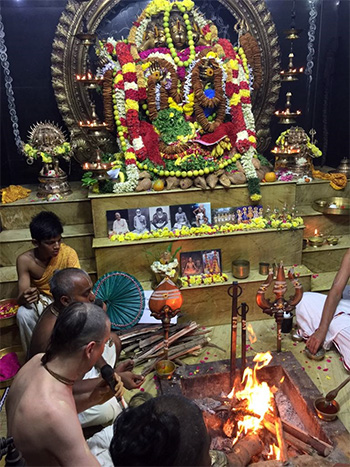Question: Why is varnashrama or Vedic dharma manifested only in India and not in the rest of the world?
To understand this answer we must study the philosophy of the history of the world, especially in reference to political geography – the various lands and countries. At the time of Yudhishthira Maharaja the whole planet, all the six continents, were ruled under one flag. This rule lasted until Yudhishthira Maharaja. Before that it was even more perfect, and the Bharata-khanda or India was from the Caspian sea up to Cambodia; and in the north, if you want to see in regards to the present countries, you can say from Lithuania to seven thousand miles south of Cape Comorin (in South India). That is what is meant by Bharata-khanda; that is fifty-four countries, the “India”; and then there are other countries apart from India.
India was made up of these fifty-four countries, and there were also other countries existing at that time. In those other countries the varnasrama was not perfectly practiced. In India (Bharata-khanda) this varnasrama (Vaidhika-dharma) was perfectly in practice.
After the Mahabharata war, and after the “dark age” in between there was a lot of mixing up – people leaving from here and coming back from there. So we find that remnants are there only in India. You can practically say that even in India now it is not there. So, if in India it is not there, then you can understand why in other places it is not there. India is the heart of varnashrama, but the heart itself is in a bypass surgery stage. So, naturally the rest of the body must be mute.
It’s only a question of the changes of time. For example, today, due to the spreading of Krishna consciousness, varnasharama is being more perfectly practiced in the western countries than in India itself. So this is all due to the changes of time. If you look back in history, you can see that it was the other way before.
It is not that the varnashrama belongs to one country. Civilization starts with varnashrama. Sometimes civilization in one part of the world may be high, and sometimes in another part it may be high. In which ever it is high or low, the closest remnants will be seen in the heart. This is why it looks like varnashrama, or caste, or anything is Indian; but that’s not so.
Anywhere in the world there is natural divisions – intellectual class, administrative class, business class and working class. That’s what varnashrama means in its essence. However you see it, it is only when people are civilized that it is functional; but if they are not civilized it is not functional.
Civilized means with a spiritual goal for life. This is the indication of civilization. But when that goal is not spiritual, when it becomes materialistic, then naturally the divisions of varnashrama end up as castes, tribes, clans and the like. It again changes wherever the spiritual goal is pinpointed in a human civilization. There the varnashrama becomes the first sign of civilization, the division of society. But this is only if the spiritual goal is put as the target.
When discussing varnasrama we must understand the two classifications, namely daiva (spiritual) varnashrama and arthika (material) or asuri varnashrama.
Daiva varnashrama is the perfect ideal which we are talking about. Even in ancient India, it was not that it was always daiva varnashrama being practiced. That is always fluctuating. And sometimes it is even found that the demons follow daiva varnashram more perfectly. For example, at the time of Mahabali, the asuras were following daiva varnashrama more perfectly than the devas. This is why they were successful. So there are many details we must take into account.
The idea that varnashrama belongs to a particular geographic area is not correct. It is something to do with the culture of a civilized society. They may not be having the same name, but still, it is varnashrama. If the society is distinctly divided into the intellectual class, administrative class, business class and working class, even though they may not be using the Sanskrit words, it is still varnashrama. It may not be consisting of the rituals and other things, such as purificatory processes (samskaras) etc., but still it is the same.






